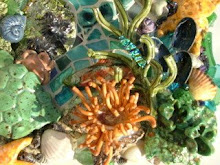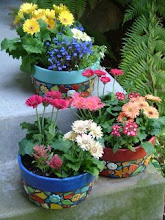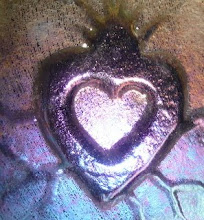 One of our many larger than life projects around the studio is the outside wall to our garden atruim. This is an area that generally gets worked on when one is tired of other projects and decides to go outside and throw a few tiles up, so progress is slow. What makes it an enjoyable enterprise however, is getting to mosaic in an "everything but the kitchen sink" fashion, with an eye towards predominately woodsy colors. Working on this wall can be happily attended to without too much forethought.
One of our many larger than life projects around the studio is the outside wall to our garden atruim. This is an area that generally gets worked on when one is tired of other projects and decides to go outside and throw a few tiles up, so progress is slow. What makes it an enjoyable enterprise however, is getting to mosaic in an "everything but the kitchen sink" fashion, with an eye towards predominately woodsy colors. Working on this wall can be happily attended to without too much forethought. The wall which runs perpendicular to this one, (sneak peek above) is a formal mural of a tropical nature. Stay posted for updates on that endeavor...
The wall which runs perpendicular to this one, (sneak peek above) is a formal mural of a tropical nature. Stay posted for updates on that endeavor...There are days mosaicing takes a back seat to a "play in the clay day." This means putting on our aprons and kindergarten hats, rolling out a slab of clay, taking out the the rubber stamps and cookie cutters and just plain having fun making whatever strikes our fancy to be fired in the kiln and put in the wall. Occasionally, literary inspiration will strike.
 Why not? Words and sayings add visual interest and inspiration, and are easy to create using the endless variety of alphabet stamps on the market. We have found the ones that work the best in clay are sold at Michaels and are marketed as stamps for concrete. They are made of hard blue plastic and can be pressed deep into the clay. Concrete alphabet stamps show up in ceramic tiles particularly well no matter what glaze you are using. Here are examples of the concrete alphabet stamps used in tiles which replicate the word groupings used in stepping stones originally created by Frank Lloyd Wright.
Why not? Words and sayings add visual interest and inspiration, and are easy to create using the endless variety of alphabet stamps on the market. We have found the ones that work the best in clay are sold at Michaels and are marketed as stamps for concrete. They are made of hard blue plastic and can be pressed deep into the clay. Concrete alphabet stamps show up in ceramic tiles particularly well no matter what glaze you are using. Here are examples of the concrete alphabet stamps used in tiles which replicate the word groupings used in stepping stones originally created by Frank Lloyd Wright. Rubber stamps are also functional, but typically more successful in polymer clay. In ceramic clay, the text is not always readily apparent because the stamp is more superficial in nature. Examples of rubber alphabet stamps in clay can be seen below in this box of tiles. Tiles read: Dreamspace and A Work of Art.
Rubber stamps are also functional, but typically more successful in polymer clay. In ceramic clay, the text is not always readily apparent because the stamp is more superficial in nature. Examples of rubber alphabet stamps in clay can be seen below in this box of tiles. Tiles read: Dreamspace and A Work of Art. Not wanting to give up on all our lovely rubber stamps, we discovered a way to deal with this problem by first rubbing black glaze into the bisqued tile words and then wiping off any of the excess glaze on the surface of the tile, and then coming back and glazing the whole tile with a solid color.
Not wanting to give up on all our lovely rubber stamps, we discovered a way to deal with this problem by first rubbing black glaze into the bisqued tile words and then wiping off any of the excess glaze on the surface of the tile, and then coming back and glazing the whole tile with a solid color. Here is an example of this technique using a small rubber stamp, where the text has been high-lighting with black glaze: the first stanza of the W. B. Yeats poem, Lake Isle of Innisfree. Much more readable.
Here is an example of this technique using a small rubber stamp, where the text has been high-lighting with black glaze: the first stanza of the W. B. Yeats poem, Lake Isle of Innisfree. Much more readable. 

























No comments:
Post a Comment